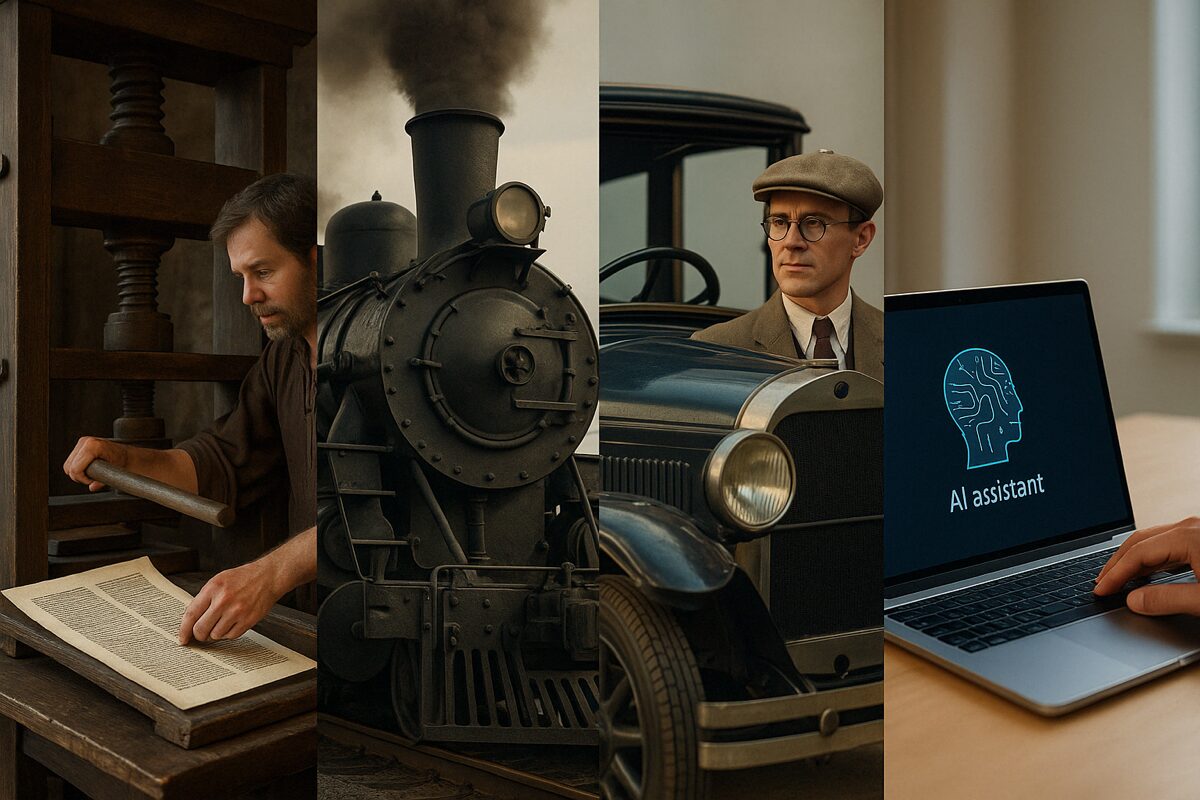
In every era, a force of change emerges that fundamentally reshapes how we live, work, and relate to the world around us. In the 15th century, it was the printing press. In the 18th, it was steam power. In the early 20th, it was the automobile. And today, we stand at the precipice of another transformation — the AI Revolution.
This isn’t just another wave of innovation. Like its historical predecessors, artificial intelligence is restructuring the very foundations of our society and workplace. To understand the scale of what’s happening, we must look both backward and forward — drawing parallels to history while preparing for what’s ahead.
Historical Parallels: When Technology Changed Everything
📚 The Printing Press (1440s)
Before Gutenberg’s invention, knowledge was a privilege of the elite. The printing press democratized information, enabling mass literacy and sparking movements like the Renaissance and the Reformation. It empowered individuals with knowledge — just as AI empowers individuals today with capabilities once reserved for experts.
Initial Resistance:
Religious and political institutions feared loss of control. Monasteries, who manually copied texts, saw it as a threat to their authority and livelihoods. There was even concern about the spread of heresy and “unauthorized” ideas.
Why It Was Adopted:
The benefits became undeniable — faster dissemination of knowledge, lower costs of education, and new opportunities for trade and scholarship. Literacy exploded. Eventually, institutions adapted by printing their own materials and using the press for outreach and influence.
Parallel to AI:
AI is democratizing skills — writing, coding, designing, data analysis — offering individuals superhuman productivity without formal training.
🚂 Steam Power & The Industrial Revolution (1760s – 1840s)
Steam engines revolutionized production and transport. The world shifted from manual labor and agrarian lifestyles to mechanized manufacturing and urban growth. It was disruptive, painful for some, and a launchpad for modern economies.
Initial Resistance:
Workers feared job loss — rightly so in many cases. The Luddite movement infamously protested by destroying machinery. Others criticized the pollution, harsh factory conditions, and the dehumanization of labor.
Why It Was Adopted:
Despite the disruption, steam power boosted productivity, lowered the cost of goods, and accelerated transportation and communication. New jobs emerged in cities, and eventually labor laws improved conditions. Economic growth made the transition unavoidable.
Parallel to AI:
Just as steam displaced manual jobs, AI is automating knowledge work. And like steam, AI is spawning entirely new industries — from AI ethics consulting to virtual agent development.
🚗 The Automobile (1900s – 1920s)
Cars altered urban planning, global trade, personal mobility, and employment (think: mechanics, highways, gas stations). Entire industries emerged in its wake.
Initial Resistance:
Horse carriage drivers, blacksmiths, and city planners resisted the shift. Some feared the dangers of speed and mechanical failure. Early cars were expensive, noisy, and seen as playthings for the rich. Public safety concerns and lack of infrastructure also slowed adoption.
Why It Was Adopted:
Mass production (thanks to Ford’s assembly line) made cars affordable. The freedom and efficiency of personal travel became irresistible. Societies built roads, regulations, and industries around it. The automobile became a symbol of progress and independence.
Parallel to AI:
AI is not just adding tools — it’s changing how we think about work itself. Meetings, emails, even decision-making processes are now being redesigned with AI assistance in mind.
🧠 What Do We Call This Era?
While terms like The AI Revolution and The Fourth Industrial Revolution are commonly used, some thinkers propose a more specific framing:
- The Cognitive Revolution 2.0 – Building on the evolution of human language and reasoning, this new phase leverages machines to augment or simulate thinking itself.
- The Automation Age – Highlighting the shift from manual to mental labor automation.
- The Intelligence Economy – Where economic value is increasingly generated through algorithmic insight, not just human labor.
🔍 Key Insights: What We’re Learning
1. AI is Transforming the Nature of Work, Not Just the Tools
The most profound shift isn’t just that AI can write your emails — it’s that your role may evolve from doing the work to orchestrating it.
2. Jobs Won’t Disappear — They’ll Transform
Just as blacksmiths became auto mechanics, and typists became digital assistants, most roles will evolve. The key will be adaptability, curiosity, and AI fluency.
3. New Inequalities May Emerge
As with every revolution, those with access to the tools and education benefit first. Digital equity and inclusive policy will matter more than ever.
4. We Need a New Social Contract
As machines take on more human-like capabilities, society will need to rethink questions of data rights, intellectual ownership, and even the definition of work.
📌 Takeaways for Families, Professionals, and Educators
| Group | Actionable Steps |
|---|---|
| Families | Talk openly about AI tools at home. Use them together. Encourage kids to experiment, but emphasize ethics and privacy. |
| Professionals | Don’t just resist automation — lead it. Learn prompt engineering, explore AI copilots, and rethink how you spend your time. |
| Educators | Teach thinking with AI, not just about AI. Focus on critical thinking, digital literacy, and interdisciplinary problem-solving. |
🧭 Moving Forward with Purpose
AI, like the revolutions before it, is not inherently good or bad. It is a mirror of our values and a magnifier of our intentions. Just as steam powered our cities and the printing press fueled democracy, AI holds the potential to empower or divide — depending on how we choose to wield it.
At Keystone Learning, we believe in human-centered innovation — that technology should support your life, not overwhelm it. As the AI Revolution unfolds, we’ll be here to help you and your family navigate it with confidence, curiosity, and care.
